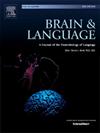解离汉语口语词汇产生过程中习得年龄效应和词频效应的时间过程
IF 2.3
2区 心理学
Q1 AUDIOLOGY & SPEECH-LANGUAGE PATHOLOGY
引用次数: 0
摘要
理解和产生研究有力地证明了早习和频繁词汇比晚习和不频繁词汇分别具有加工优势。由于习得年龄(AoA)和词频(WF)在本质上是相关的,这两个因素在多大程度上共同或单独影响语音产生尚不清楚。本研究旨在通过电生理手段探讨汉语口语词生成中AoA和WF效应的潜在机制。我们正交操纵AoA和WF来检查这些变量何时以及如何共同影响口语生产。结果表明,在概念准备的时间窗内(图像开始后78-170 ms), AoA和WF之间存在相互作用,随后在词汇选择(240-322 ms)和语音编码(462-566 ms)中分别存在AoA和WF的独立作用。因此,我们的研究结果为语音产生中AoA和WF效应的交互和孤立起源提供了支持。本文章由计算机程序翻译,如有差异,请以英文原文为准。
Dissociating the time courses of age of acquisition effect and word frequency effect during Chinese spoken word production
Comprehension and production research robustly demonstrates a processing advantage of early-acquired and more frequent words than late-acquired and infrequent words separately. Because age of acquisition (AoA) and word frequency (WF) are correlated in nature, to what extent both factors jointly and independently affect speech production remains unclear. This study aimed to investigate underlying mechanisms behind AoA and WF effects in Chinese spoken word production with electrophysiological measures. We orthogonally manipulated AoA and WF to examine when and how these variables jointly affect spoken production. Results illustrated an interaction between AoA and WF in a time window of conceptual preparation (around 78–170 ms after picture onset) and subsequently an independent AoA effect at lexical selection (240–322 ms) and a WF effect at phonological encoding (462–566 ms). Our findings therefore provide supports for interactive and isolated origins for AoA and WF effects in speech production.
求助全文
通过发布文献求助,成功后即可免费获取论文全文。
去求助
来源期刊

Brain and Language
医学-神经科学
CiteScore
4.50
自引率
8.00%
发文量
82
审稿时长
20.5 weeks
期刊介绍:
An interdisciplinary journal, Brain and Language publishes articles that elucidate the complex relationships among language, brain, and behavior. The journal covers the large variety of modern techniques in cognitive neuroscience, including functional and structural brain imaging, electrophysiology, cellular and molecular neurobiology, genetics, lesion-based approaches, and computational modeling. All articles must relate to human language and be relevant to the understanding of its neurobiological and neurocognitive bases. Published articles in the journal are expected to have significant theoretical novelty and/or practical implications, and use perspectives and methods from psychology, linguistics, and neuroscience along with brain data and brain measures.
 求助内容:
求助内容: 应助结果提醒方式:
应助结果提醒方式:


